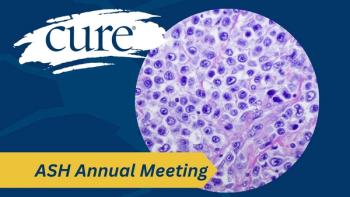
Trodelvy May Provide Benefits in Extensive-Stage Small Cell Lung Cancer
Patients with extensive-stage small cell lung cancer responded well to the treatment of Trodelvy, according to preliminary results from a phase 2 trial.
Patients with extensive-stage small cell lung cancer (ES-SCLC) benefited from receiving Trodelvy (sacituzumab govitecan-hziy) as second-line treatment, according to results from a phase 2 trial presented at the
Trodelvy is a drug that contain the monoclonal antibody sacituzumab, which binds to TROP2, a protein that can be found on some cancer cells. The drug also contains the anti-cancer drug SN-38, which could help kill cancer cells, according to National Cancer Institute.
In the 30 patients treated prior to the data cutoff date, the median age was 67 years, and 60% of patients were female. Ninety percent of patients were White, and 97% were current or former smokers.
The majority of patients had stage 4 disease at initial diagnosis (93%). Fifty percent of patients experienced a complete response or partial response to their last prior anticancer therapy and 33% had stable disease or progressive disease on their last prior therapy.
At a median follow-up of 5.1 months, the overall response rate (ORR; percentage of patients in a study who had a complete or partial response to treatment) was 37%.
All responders experienced a confirmed partial response, and the rates of stable disease and progressive disease were 50% and 10%, respectively. The median duration of response (DOR; length of time when a tumor responds to treatment without progressing) was 6.3 months and the six-month DOR rate was 63%.
“Seventy-seven percent of patients (who underwent) post-baseline tumor assessment (experienced) some kind of tumor reduction, and 43% had a reduction of greater than 30%,” lead study author Dr. Afshin Dowlati said in a presentation of the data. “Very few patients had up-front (disease) progression on their first imaging.”
Dowlati is a professor in the department of medicine division of hematology and oncology in the school of medicine, associate director for clinical research and a member of the developmental therapeutics program at Case Comprehensive Cancer Center in Cleveland, Ohio.
Trodelvy previously received full approval from the FDA
The regulatory agency also
The ongoing, open-label, multicohort TROPiCS-03 study is evaluating Trodelvy in patients with locally advanced or metastatic solid tumors, including ES-SCLC.
To enroll in the ES-SCLC cohort, patients are required to have histologically confirmed ES-SCLC that progressed after no more than one prior line of platinum-based chemotherapy and anti-PD-1 or -PD-L1 therapy. Patients with active central nervous system metastases and/or carcinomatous meningitis are not permitted.
Investigators plan to enroll approximately 40 patients in the ES-SCLC cohort. Treatment consists of 10 mg/kg of intravenous Trodelvy on days 1 and 8 of each 21-day cycle until progressive disease or unacceptable toxicity.
Investigator-assessed ORR serves as the trial’s primary endpoint. Secondary endpoints include investigator-assessed DOR and progression-free survival (length of time during and after treatment when a patient lives with cancer but it does not worsen), overall survival (length of time from diagnosis or the beginning of treatment when patients are still alive) and safety.
Regarding safety, all patients experienced any grade treatment-emergent side effects, and 93% had treatment-emergent side effects deemed related to study treatment. Grade 3 or higher treatment-emergent side effects occurred in 60% of patients, 50% of which were related to treatment. The rates of serious treatment-emergent side effects and those related to treatment were 30% and 13%, respectively.
Twenty-seven percent of patients experienced treatment-emergent side effects that led to dose reductions. However, treatment-emergent side effects did not lead to treatment discontinuation or death in any patients.
The most common treatment-emergent side effects reported in at least 15% of patients included diarrhea, neutropenia (lower levels of white blood cells), constipation, fatigue, nausea, alopecia (hair loss), anemia, decreased appetite, vomiting, abdominal pain and hypomagnesemia (electrolyte disturbance due to low serum magnesium levels).
“These results are encouraging in (patients with) ES-SCLC. The trial is ongoing, and we will hopefully have full results early (in 2024) with a full cohort. We believe that further investigation of (Trodelvy) in SCLC is warranted,” Dowlati concluded.
For more news on cancer updates, research and education, don’t forget to





